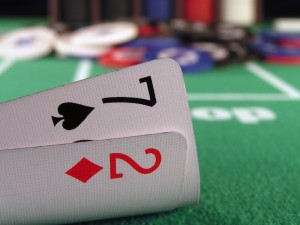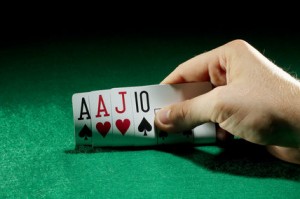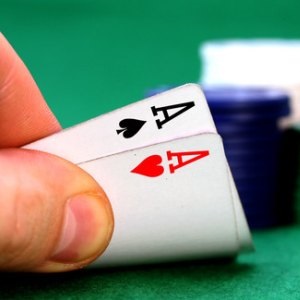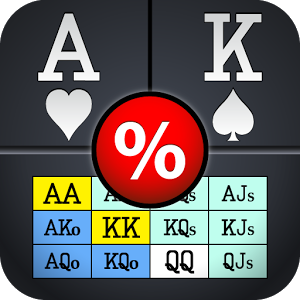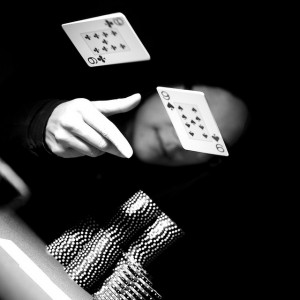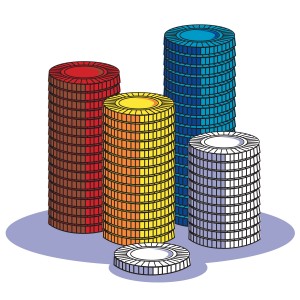A mission to beat 900 players begins
This article looks at some of the more interesting hands I played while winning the PokerStars Nightly Hundred Grand tournament. These tournaments typically attract around 900 players, with first place paying approximately $30,000.
We started out with $2,000 in chips, and the blinds were $10-$20. On the third hand, I was dealt jacks in the big blind. A player in early-middle position raised to $60, and I called. The flop came 9-8-5 rainbow. I checked, my opponent bet $80, and I called. The turn was a deuce and we both checked. The river was a 3, I bet out $225 into a $290 pot, and my opponent folded.
This is a rather unexciting hand, but demonstrates a key no-limit hold’em principle: keeping the pot small. Several of the members of our poker forum said that after they read the discussion of this hand, they realized that they probably were playing jacks too aggressively. One member stated, “I’ve been playing jacks more aggressively early on. This probably causes me to win smaller pots and lose bigger ones compared to the concept demonstrated here.”
I couldn’t have stated this better myself. The end result of playing the hand more aggressively is that your opponent will usually fold, except when he has you beat. I am willing to accept the risk of giving free cards to possible overcards in return for keeping the pot small. This strategy also will gain you bets sometimes by inducing your opponent to either bluff the turn or make a crying call on the river.
Hand No. 65 was an interesting one, as I got very lucky to win a big pot. The under-the-gun player, with $2,600 in chips, raised to $300 with $50-$100 blinds. I had $6,000 in chips and elected to call from the button with the 4 3
3













A lot of the members of my forum who saw my entire hand history asked about my strategy of calling raises while in late position with seemingly weak hands, such as 10-9 offsuit, 4-3 suited, and K-9 suited. Position is very powerful in no-limit hold’em. You can often win pots on the flop or turn simply by betting with nothing. And, of course, sometimes you’ll hit a big hand. The tricky part is making sure that you don’t lose a lot when you hit a mediocre hand and are up against a big hand.
In this particular hand, the flop comes A

























My opponent calls, so I am basically finished with this hand. The turn actually helps me, though, when the 10







































By hand No. 129, I had built my stack up to $8,300 and the blinds were now $150-$300 with $15 antes. We were eighthanded and I raised to $700 from middle position with A-J. The button, with $13,000 in chips, called, and the big blind moved all in to $2,100. There was now about $3,400 in the pot, and I was facing a $1,400 call. I could either call or reraise to isolate.
The problem with calling is that I would be playing A-J out of position against an opponent with a big stack. I am getting about 2.4-to-1 pot odds to call against the all-in player. He could have a wide range of hands, given that he is short-stacked, so A-J is certainly getting the odds to play.
I elect to reraise all in to isolate. Of course, there is the risk that the button was trapping with a big hand, but I’m willing to take that risk to get it heads up. If our stacks were, say, double what they were, I probably would just call. But in this case, we’re talking about a $3,000 pot when I have $8,000. This situation came up several times in the tournament when I was holding A-J, and I reraised to isolate. The button folds, the player in the big blind has A-3 offsuit, and my hand holds up.
In hand No. 181, we were very close to making the money. I now had $18,000 in chips with the third-largest stack at the table. The blinds were $400-$800 with $40 antes. I raised to $2,200 from under the gun with the 9











































This is a tough question. The first thing is to try to narrow down the range of hands that he might be holding. The most obvious choices are a flush draw and pocket pairs. He also could have trips, or a pure bluff is always a possibility, although I suspect that is doubtful in this case. I believe that most opponents would reraise preflop with aces, kings, or queens. Of course, he could be slow-playing them, but most opponents probably would not. With fours, fives, sixes, sevens, or eights, some opponents might push, while some might not. Most opponents probably will push with nines, tens, or jacks on this board. There are many hands that make for an easy call, such as eights, sevens, 7-6 suited, A-X suited, and K-X suited.
Overall, I am probably behind, but I am also getting 1.8-to-1 pot odds, which seems like a call I should make, although reluctantly. It turns out that my opponent was sitting on tens, and I got very lucky to spike a 9 on the turn.
When on a mission to beat 900 players over the course of 500 hands, you need to have some lucky breaks. I had my fair share, while also using my stack to put pressure on my opponents to build more and more chips. part II takes a look at the heads-up battle, which lasted about 50 hands.
Heads-Up Play
Heads-up play lasted around 50 hands.
I had $820,000 in chips, compared to my opponent’s $1,025,000. The blinds were $15,000-$30,000, with a $1,500 ante. My opponent was a rather straightforward, relatively passive player. When heads-up play began, I switched my style by calling a lot preflop rather than raising, as I had been doing earlier. This strategy enabled me to keep the pots small in order to minimize my risk on any given hand.
On the very first hand (hand No. 497), my opponent called from the button and I simply checked my pair of nines. Raising would build a pot out of position – something I wanted to avoid. The flop came J-3-2. I bet out $50,000 and my opponent folded.
The very next hand crippled my opponent. I was dealt 7-5 and called from the button. The flop came 8-5-5 with two clubs. My opponent checked, I bet $40,000, and he called. The turn was a 7, giving me a full house. My opponent checked, I bet $100,000, and he raised to $270,000. I elected to just call, hoping to represent a draw or weak pair. The river was a 10, and my opponent bet $360,000. I moved all in for $509,000 and he folded. I now had a commanding chip lead with $1.5 million, with my opponent sitting on about $300,000 in chips.
In hand No. 501, my opponent limped in and had $320,000 remaining. I decided to push with A-7 suited. My opponent was not the type to slow-play premium hands, and raising sent a message to him not to limp in from the button on the cheap. He folded.
Hand No. 506 was a disappointing blow. I called from the button with the K





















































































In hand No. 509, he moved all in for $488,000 and I folded deuces. At best, I was in a coin-flip situation, and the worst case was that I was a 4-1 dog. This hand indicated that my opponent didn’t want to play flops.
I was a little unlucky again on hand No. 510. I had 6-5 on a Q-4-3 flop. We both checked and a 5 came on the turn. My opponent bet $40,000 and I called. The river was a deuce, giving us both a straight, as he showed 6-4.
In hand No. 514, I called and my opponent moved all in for $508,000, indicating once again that he preferred not to see flops.
In hand No. 518, I elected to simply call with A-K suited, hoping to set a trap, but my opponent didn’t fall for it and I picked up the pot on a flop of king high.
In hand No. 522, I limped in from the button with 4-2 suited. The flop was 5-4-2 rainbow. My opponent checked and I bet $50,000. He pushed all in to $470,000 and I called. He showed 7-3 and hit a straight on the river.
At this point, it was important to keep my cool and continue to play my game. This tournament had gone on for a little more than seven hours, and we were basically playing for about $12,000, which was the difference between first and second place. I had played too long to start getting desperate and upset over bad beats.
My opponent now held about $1 million in chips, while I had about $800,000. By hand No. 532, I was down to $710,000. I called from the button with 9-7 offsuit. The flop came 10-9-8 and my opponent checked. I bet $50,000 and he called. The turn was a jack and we both checked. The river was a 4 and my opponent checked. I bet $150,000 and he called with 9-6. I now had the slightest of chip leads.
In hand No. 534, I called from the button with the 8







































The blinds moved to $25,000-$50,000, with a $2,500 ante. My opponent had $600,000 in chips. He limped in from the button and I pushed him all in again with K-Q offsuit, hoping to pick up the $105,000 in the pot. At this point, the blinds and antes were worth a lot, given my opponent’s stack of $600,000. He folded.
In hand No. 537, my opponent pushed all in for $491,000 and I folded A-5 suited. He hadn’t pushed too frequently, so I was probably a dog, and possibly a big one. If I was a favorite, I would be only a small one. I certainly might take this risk against a top-flight opponent, but in this particular case it didn’t seem necessary to take this big a risk at this particular time.
In hand No. 538, I limped in with pocket queens, hoping to trap, and picked up the pot on a ragged flop. Unfortunately, I couldn’t get my opponent to take the bait!
In hand No. 543, my opponent limped in from the button and I pushed all in with 9-6 suited. This might seem risky, but he hadn’t tested me yet with a change in style. His raises generally indicated strength, while his calls indicated weakness. A hand of 9-6 suited certainly isn’t extremely strong, but it would play well enough if my opponent called. He folded.

In the final hand, I limped in with K-Q offsuit and the flop came K-9-2. We both checked. The turn was my money card – a queen! My opponent bet $70,000 and I put him all in for an additional $340,000, and he showed K-9.
This was a long heads-up match with a lot of ups and downs. When you have an advantage over your opponent, it is important to pick your spots and try to avoid high-risk plays. At the same time, you want to continue to put the pressure on your opponent when possible. In this particular match, I tried to keep the pots small and pick them up when my opponent showed weakness. These little pots add up over time, giving you a big advantage over your opponent.
Submit your review | |



